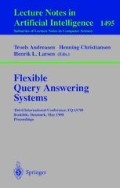Abstract
In previous work we presented a diagrammatic syntax for logic programming which clearly ‘resembles’ the semantics of predicates as relations, i.e. sets of tuples in the Universe of Discourse. This paper shows diagrams as an alternative formal notation for pure logic programming which not only emphasizes some structural features of logical statements, but could also be useful to conduct visual inferences and to communicate them. This paper describes the current state of our research on a visual inference system for answering visually posed queries by means of diagram transformations. Although the transformations are shown by example we point to their correctness and formal character. We explore two interesting features provided by its diagrammatic nature: First, the ability of intuitively keeping track—within a diagram—of the proof that is built while solving a query, and second, the possibility to represent within a unique diagram the several different alternatives to answer a query.
Supported by project MODELOGOS funded by the CICYT (TIC 97-0579-C02-01)
On leave from the IIIA supported by a doctoral grant from the Direcció General de Recerca
Preview
Unable to display preview. Download preview PDF.
References
J. Agustí, J. Puigsegur, and D. Robertson. A visual syntax for logic and logic programming. Journal of Visual Languages and Computation, 1998. To be published.
G. Allwein and J. Barwise, editors. Logical Reasoning with Diagrams. Oxford University Press, 1996.
L. Bachmair and H. Ganzinger. Rewrite techniques for transitive relations. In 9th Annual IEEE Symposium on Logic in Computer Science, pages 384–393, 1994.
J. Barwise and J. Etchemendy. Hyperproof. CSLI Publications, 1993.
J. Barwise and E. Hammer. Diagrams and the concept of logical system. In Logical Reasoning with Diagrams, chapter III, pages 49–78. Oxford University Press, 1996.
M. Borman, J. A. Bubenko, P. Johannensson, and B. Wangler. Conceptual Modelling. Prentice Hall, 1997.
W. Citrin, R. Hall, and B. Zorn. Programming with visual expressions. In Proc. of the 11th IEEE Symposium on Visual Languages. IEEE Computer Press, 1995.
Y. Deville. Logic Programming. Addison Wesley, 1990.
E. M. Hammer. Logic and Visual Information. CSLI Publications & FoLLI, 1995.
H. J. Klein and D. Krämer. NQS — a graphical query system for data models with binary relationship types. In S. Spaccapietra and R. Jain, editors, Proc. of the 3rd IFIP 2.6 Working Conference on Visual Database, 1995.
J. Levy and J. Agustí. Bi-rewriting, a term rewriting technique for monotonic order relations. In C. Kirchner, editor, Rewriting Techniques and Applications, LNCS 690, pages 17–31. Springer, 1993.
J. Levy and J. Agustí. Bi-rewrite systems. Journal of Symbolic Computation, 22:1–36, 1996.
D. A. McAllester and R. Givan. Natural language syntax and first-order inference. Artificial Intelligence, 56:1–20, 1992.
M. A. Najork. Programming in three dimensions. Journal of Visual Languages and Computation, 7:219–242, 1996.
J. Puigsegur and J. Agustí. Towards visual declarative programming. Research report, Institut d'Investigació en Intel.ligència Artificial (CSIC), 1998.
J. Puigsegur, J. Agustí, and J. A. Pastor. Towards visual schemas in deductive databases. Research report, Dep. LSI, Universitat Politècnica de Catalunya, 1998.
J. Puigsegur, J. Agustí, and D. Robertson. A visual logic programming language. In 12th Annual IEEE Symposium on Visual Languages. IEEE Computer Society Press, 1996.
J. Puigsegur, W. M. Schorlemmer, and J. Agustí. From queries to answers in visual logic programming. In 13th Annual IEEE Symposium on Visual Languages. IEEE Computer Society Press, 1997.
D. D. Roberts. The Existential Graphs of Charles S. Peirce. Mouton and Co., 1973.
A. Shimojima. Operational constraints in diagrammatic reasoning. In Logical Reasoning with Diagrams, chapter II, pages 27–48. Oxford University Press, 1996.
J. F. Sowa. Conceptual graphs. Information Processing in Mind and Machine, 1984.
J. F. Sowa. Relating diagrams to logic. In G. W. Mineau, B. Moulin, and J. F. Sowa, editors, Conceptual Graphs for Knowledge Representation, Proc. of the First Int. Conf. on Conceptual Structures, ICCS'93, LNAI 699. Springer, 1993.
L. Spratt and A. Ambler. A visual logic programming language based on sets and partitioning constraints. In Proc. of the 9th IEEE Symposium on Visual Languages. IEEE Computer Press, 1993.
Author information
Authors and Affiliations
Editor information
Rights and permissions
Copyright information
© 1998 Springer-Verlag Berlin Heidelberg
About this paper
Cite this paper
Agustí, J., Puigsegur, J., Schorlemmer, W.M. (1998). Query answering by means of diagram transformation. In: Andreasen, T., Christiansen, H., Larsen, H.L. (eds) Flexible Query Answering Systems. FQAS 1998. Lecture Notes in Computer Science, vol 1495. Springer, Berlin, Heidelberg. https://doi.org/10.1007/BFb0055988
Download citation
DOI: https://doi.org/10.1007/BFb0055988
Published:
Publisher Name: Springer, Berlin, Heidelberg
Print ISBN: 978-3-540-65082-9
Online ISBN: 978-3-540-49655-7
eBook Packages: Springer Book Archive

